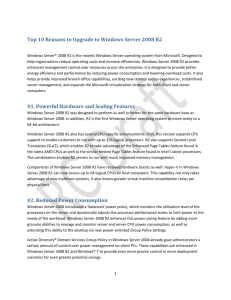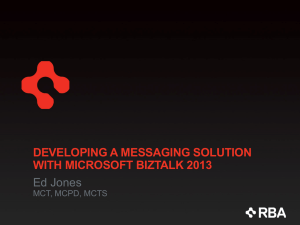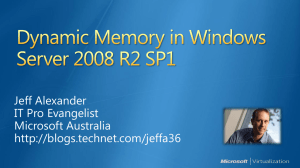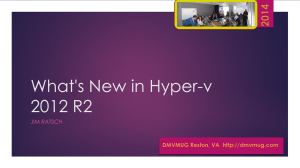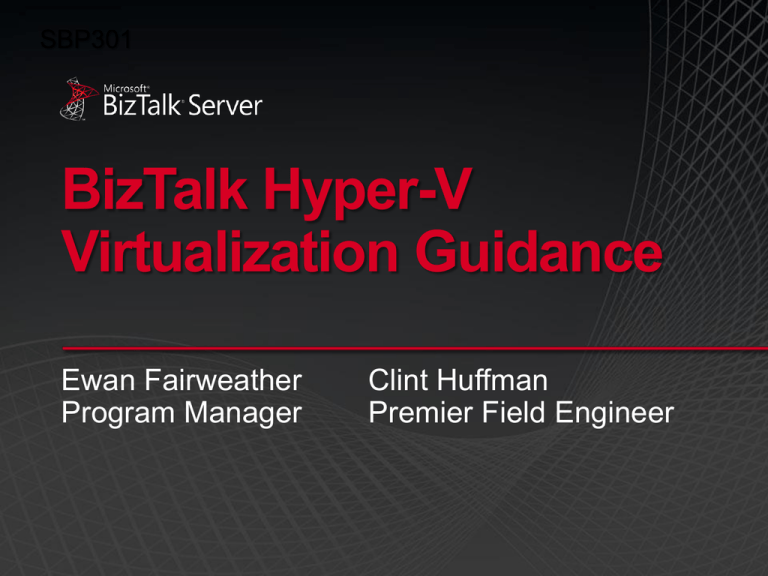
BizTalk Hyper-V
Virtualization Guidance
Ewan Fairweather
Program Manager
Clint Huffman
Premier Field Engineer
Session Objectives
•
•
•
Share the best practices for using BizTalk
with Hyper-V
Provide guidance on the performance
characteristics of BizTalk on Hyper-V
Introduce the BizTalk Server 2006 R2
Hyper-V Guide
Session Agenda
− Hyper-V Overview
• BizTalk Server Virtualization Assessment
•
− Scenarios & Results
− Hyper-V Performance Analysis
− Lessons Learned
Reference guidance
− BizTalk Server 2006 R2 Hyper-V Guide
Hyper-V Architecture
1
Root Partition
3
Child Partition
Child Partition
Server
Server
2 VSPs
VSPs
I/O
Stack
I/O
Stack
4
Drivers
VMBus
5
•
VSCs
Shared Memory
OS Kernel
Enlightenments
(WS08+)
VSCs
VMBus
VMBus
Hypervisor
Devices
•
I/O
Stack
Processors
Memory
VHD - single file sits on root NTFS volume
− Fixed, Dynamic, Differencing
Pass-through – exclusive disk access to guest
Differences Hyper-V vs. Virtual
Server 2005
Virtualization Feature
Virtual Server 2005 R2
Hyper-V
32-bit virtual machines
Yes
Yes
64-bit virtual machines
No
Yes
1
Multi-processor virtual machines No
Yes, 4 core VMs
2
Virtual Machine Memory
Support
3.6GB per VM
64GB per VM
3
Managed by System Center
Virtual Machine Manager
Yes
Yes
Support for Windows Clustering
Yes
Services
Yes
Host side backup support (VSS) Yes
Yes
Scriptable / Extensible
Yes, COM
Yes, WMI
User Interface
Web Interface
MMC 3.0 Interface
BizTalk Virtualization Licensing
•
•
•
•
License required for each physical
processor
License for each virtual processor in each
virtual operating system
Exception: BizTalk Enterprise Edition
− License for the number of physical processors
in the server
− Enables unlimited virtual processors
http://www.microsoft.com/biztalk/en/us/prici
ng-licensing-faq.aspx
Hyper-V Supportability Overview
•
•
•
•
BizTalk Server 2004/2006/2006 R2 fully
supported
− http://support.microsoft.com/kb/842301
SQL Server 2005 provides commercially
reasonable support
BizTalk Server 2009 will provide full HyperV support
SQL Server 2008 will provide full Hyper-V
support
Hyper-V Performance Overview
•
•
•
•
Our results indicate that performance is
good
Virtual processors scale well
Storage design should be considered
carefully
Hyper-V provides more pieces to monitor:
− Performance counters
− xPerf/ETW should be used for performance
analysis
Session Agenda
− Hyper-V Overview
• BizTalk Server Virtualization Assessment
− Scenarios & Results
•
− Hyper-V Performance Analysis
− Lessons Learned
Reference guidance
− BizTalk Server 2006 R2 Hyper-V Guide
Scenario 1: Physical to Virtual Comparison
1
2
Scenario 1: Results
2
1
4
3
•
•
Throughput 75% in Virtual environment
Latency 20-30% less in Virtual environment
Scenario 2: Multiple VMs
1
2
Scenario 2: Results
4
3
2
1
•
•
Throughput 75% in virtual environment
Ratio of logical to virtual processors affects
throughput
Scenario 3: Virtual SQL
1
2
Scenario 3: Results
2
1
•
•
Almost identical performance
Virtual processors scale for SQL
Scenario 4: Consolidated
1
2
3
Scenario 4: Results
1
2
3
Scenario 4: Results (cont.)
1
2
3
Scenario 4: Results (cont.)
•
•
•
•
•
~80% of the throughput relative to when the
virtual BizTalk Server and SQL Server
machines were hosted on separate
hardware
~10% overhead of running both groups
simultaneously
Networking performs well
Running two groups only placed ~40% CPU
load on the physical server
Adding additional virtual machines
increases load on Hyper-Visor
Session Agenda
− Hyper-V Overview
• BizTalk Server Virtualization Assessment
− Scenarios & Results
− Hyper-V Performance Analysis
•
− Lessons Learned
Reference guidance
− BizTalk Server 2006 R2 Hyper-V Guide
Hyper-V Processor Utilization
% Processor Time performance counters on the root partition are not
accurate. Use the % Guest Run Time and % Total Run Time counters
Root Partition (physical host)
3
Virtual BizTalk
% Processor Time
100%
Root Partition % Processor Time
1
100%
2%
2
3%
90%
90%
90%
\Hyper-V Hypervisor Logical
Processor(*)\% Guest Run Time
% Processor Time
100%
4%
4
90%
Virtual BizTalk
5%
100%
5
95%
95%
95%
95%
\Hyper-V Hypervisor Logical
Processor(*)\% Total Run Time
Hyper-V Performance
Counters
Clint Huffman
Premier Field Engineer (PFE)
Premier Field Engineering (PFE)
1 to 1 Mapping
1
Overload Scenario
BizTalk Server
BizTalk Server
Virtual Processors
Virtual Processors
0
0
2
BizTalk Server
BizTalk Server
Virtual Processors
Virtual Processors
0
0
1
1
BizTalk Server
BizTalk Server
BizTalk Server
BizTalk Server
Virtual Processors
Virtual Processors
Virtual Processors
Virtual Processors
0
0
0
1
2
Logical Processors
0
3
0
1
0
1
2
Logical Processors
1
3
Session Agenda
− Hyper-V Overview
• BizTalk Server Virtualization Assessment
− Scenarios & Results
− Hyper-V Performance Analysis
•
− Lessons Learned
Reference guidance
− BizTalk Server 2006 R2 Hyper-V Guide
Processor Lessons Learned
•
•
% Processor Time on the Host does not
measure physical processors
For high processor usage:
− Most Efficient: 1:1 Logical to Virtual
Processors
− Better Performing, Less Efficient: 2:1 Logical
to Virtual Mapping of Processors
Processor Lessons Learned
•
•
•
To measure Guest processors:
− \Hyper-V Hypervisor Virtual Processor(*)\%
Guest Run Time
− \Hyper-V Hypervisor Virtual Processor(*)\%
Total Run Time
To measure Physical processors:
− \Hyper-V Hypervisor Logical Processor(*)\%
Total Run Time
To measure Host processors:
− \Hyper-V Hypervisor Root Virtual
Processor(*)\% Total Run Time
Disk Lessons Learned
•
•
For VHDs use:
−
−
−
−
<RootPartition>\Logical Disk(*)\Avg. sec/Read
<RootPartition>\Logical Disk(*)\Avg. sec/Write
<Guest>\Logical Disk(*)\Avg. sec/Read
<Guest>\Logical Disk(*)\Avg. sec/Write
For PassThrough Disk Analysis use:
− “Hyper-V Virtual Storage Device” counters
− xPerf Tool http://msdn.microsoft.com/enus/library/dd871252.aspx
Pass-Through Disk Perf
Measurement
Physical SQL
Physical Disk
Virtual SQL
Pass-through
Disk
Difference
Transfers/Sec
269.73
250.47
7%*
Transfers (reads/writes) per
second
Virtual SQL PassThrough Disk
Transfers (reads/writes)
per second
Physical SQL
Physical Disk
0
100
200
300
* Other factors such as SAN performance could have been a factor
Disk Lessons Learned
•
Use PassThrough disks for high disk I/O:
−
−
−
−
BizTalk MessageBox Database
BizTalk Tracking Database
BizTalk File Adapter
%temp directory if BizTalk is streaming large
files
Memory Lessons Learned
•
•
•
Virtual machines require non-paged
memory (physical memory)
Ensure you have enough physical memory
on both the host and guest computers
Use Traditional Counters:
−
−
−
−
<RootPartition>\Memory\Available Mbytes
<Guest>\Memory\Available Mbytes
<RootPartition>\Memory\Pages/sec
<Guest>\Memory\Pages/sec
Network Lessons Learned
•
•
For high network I/O:
− Use a 1:1 mapping of physical to virtual
network adapters
For measuring network adapters use:
− <RootPartition>\Network Interface
− Bytes Total Per Second
− Output Queue Length
− <RootPartition>\Hyper-V Virtual Network
Adapter
− Bytes Per Second
− <RootPartition>\Hyper-V Virtual Switch
Perf Analysis Tools
•
•
•
•
Performance Monitor
Performance Analysis of Logs (PAL) tool
− http://www.codeplex.com/PAL
xPerf from the Win2008 SDK
− http://www.microsoft.com/whdc/system/sysperf/
perftools.mspx
IOMeter
− http://www.iometer.org/
Perf Analysis Tools (cont)
•
•
Visual Studio Command Line Profiler
− http://go.microsoft.com/fwlink/?LinkId=105797
BizTalk Artifact Duration Aggregations
− http://blogs.technet.com/clint_huffman/archive/
2008/05/06/biztalk-artifact-durationaggregations.aspx
BizTalk Hyper-V Summary
•
•
•
•
Fundamental BizTalk design decisions have not
changed
Performance or efficiency driven
− To maximize performance use Fixed VHD not Dynamic
or Differencing disks
− >1:1 Virtual:Logical processors can degrade
performance
Pass-through for High I/O
− BizTalk – file receive locations, %temp folder
− SQL Server – System and User Databases
Hyper-V Planning and Deployment Guide
− http://download.microsoft.com/download/8/1/5/81556693-1f05494a-8d45-cdeeb6d735e0/HyperV_Deploy.doc
Where to learn more
•
•
Tony Voellm’s Blog - go here first!
− http://blogs.msdn.com/tvoellm
Windows virtualization discussion (virttalk)
Session Agenda
− Hyper-V Overview
• BizTalk Server Virtualization Assessment
•
− Scenarios & Results
− Hyper-V Performance Analysis
− Lessons Learned
Reference guidance
− BizTalk Server 2006 R2 Hyper-V Guide
BizTalk Server 2006 R2
Hyper-V Guide
MSDN: http://msdn.microsoft.com/enus/library/cc768518.aspx
Key Takeaways
•
•
•
•
•
•
BizTalk and SQL perform well on Hyper-V
BizTalk Server 2006 R2/2009 is supported
on Hyper-V
SQL 2005 currently provides commercially
reasonable support
SQL 2008 will fully support Hyper-V
BizTalk Server 2009 will enable 4 VP
support
Fully assess the risks/benefits before
deploying BizTalk on Hyper-V
© 2008 Microsoft Corporation. All rights reserved. Microsoft, Windows, Windows Vista and other product names are or may be registered trademarks and/or trademarks in the U.S. and/or other countries.
The information herein is for informational purposes only and represents the current view of Microsoft Corporation as of the date of this presentation. Because Microsoft must respond to changing market
conditions, it should not be interpreted to be a commitment on the part of Microsoft, and Microsoft cannot guarantee the accuracy of any information provided after the date of this presentation.
MICROSOFT MAKES NO WARRANTIES, EXPRESS, IMPLIED OR STATUTORY, AS TO THE INFORMATION IN THIS PRESENTATION.
Test Application Overview


